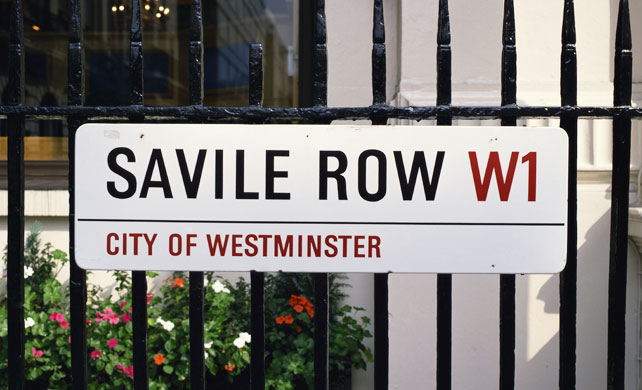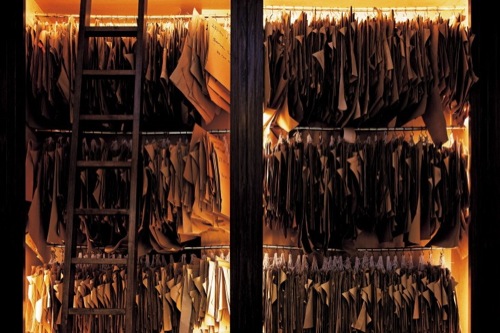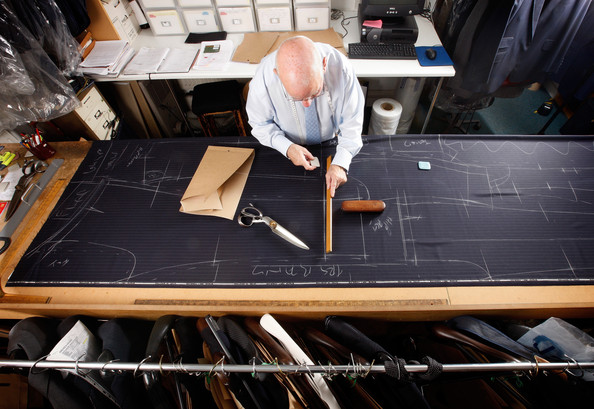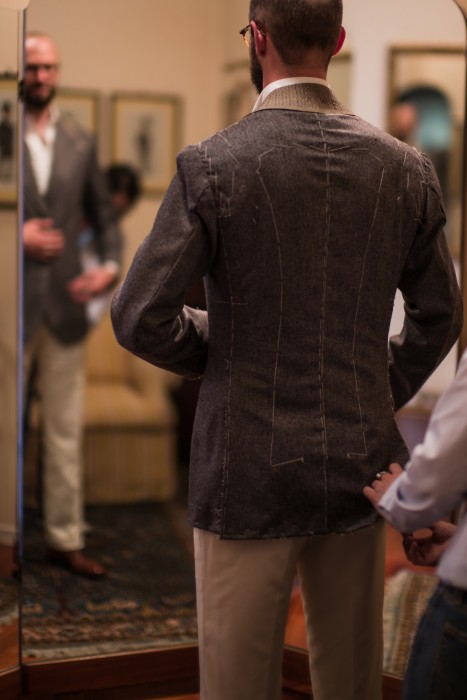Over the last week I found myself in three separate conversations around what constitutes bespoke suiting in relation to made-to-measure. Unfortunately the context of these conversations was in response to the miss-use of the word bespoke by a few makers running around town as well as online. Hopefully this post will clarify some of the confusion that is out there once and for all.
What is meant by bespoke?
I’ll start with the word bespoke itself; it’s derived from the adjective, “bespoken”, meaning “ordered, commissioned, arranged for.” In terms of bespoke tailoring it officially refers to a suit that is made on or around Savile Row in London’s Mayfair district. Over the years The Savile Row Bespoke Association has gone to great lengths to protect the word and how it’s used in terms of describing and advertising suits. Unfortunately this has been a loosing battle as the word gets shamelessly thrown around reducing its value and meaning from a craft perspective; one that has been practiced in that location to exacting standards for over two centuries. Simply put – if it’s not from Savile Row then it’s not real bespoke.
Don’t other locations in the world do bespoke though?
They do and they don’t.
I’ll start with the don’t. Tailors of this level from other parts of the world don’t refer to what they do as bespoke simply because they know better. For example in Italy – a location with an equally long and glorified tailoring tradition – they refer to the process as su misura; roughly translated as custom-made or tailor-made. Each area has their language to describe the process – in this way bespoke is specific to the English and Savile Row.
As for the type of suit that is made via this process – absolutely other locations in the world make a similar level of product. The reality though is that not many makers in the world exist that are doing it at the level we’re describing when we talk about Savile Row or the best Italian tailors of Florence and Naples. This is where things begin to get even blurrier; what goes into the process of making a suit and how it differs from level to level. With that in mind we’ll start at the top.
What sets a bespoke level suit apart?
For the sake of clarity I will continue to use the term bespoke to refer to the top level of tailoring in the world – whether it’s the famous tailoring houses of Savile Row or the historic family-based artisans of Italy.
1. Individualized Patterns
This represents the major point of difference from all other levels of tailoring. At this level each individual client has an individual pattern developed from scratch. At the initial meeting the clients posture is observed and in combination with their measurements an individual pattern is constructed onto medium card stock paper. As the client moves through the process changes are inevitably required; each of these – big and small – are recorded and the pattern is re-cut to represent what is happening with the actual suit itself. As you can imagine this is extremely time consuming but more importantly it allows for a complete history of the process to be maintained for the maker to go back to as a guide. It also provides a starting point for any further future commissions.
2. Made In House
The entire process – from observation and measuring, to pattern development, to fittings, to the final construction of the suit – must occur in-house. The level of detail and the overlapping nature of the process requires perfect unison between all people involved. As such no aspect of the process can be outsourced to an off premise location.
3. Fittings
Typically there will be three fittings – beginning with the first fitting or “skeleton baste”. This is where the basic parts of the suit (no collar or sleeves) are roughly sewn together using a basting thread – in essence this is to correct any major balance errors in the pattern. Once the changes are marked on the cloth (and on the pattern) the basting threads are ripped apart and the suit is reconstructed for the second fitting stage
The second fitting – also known as the “forward fitting” – is where the body of the jacket is pretty much completed though the collar and sleeves will still be in the skeleton stage. At this point the client will be able to get a real sense of how the suit fits and any small and specific changes are made to both the suit and pattern.
Next is either the “finish bar finish” stage or the final fitting. The “finish bar finish” is where the entire jacket is complete minus the buttonholes. This is one last moment to make sure everything is perfect before you cut holes into the cloth – of course once you hit that stage there is no turning back! This is done when there is no rush or if the client cannot be seen for a final fitting. As for the final fitting – it is of course the final check before the suit gets handed off for good.
4. Cost
Needless to say the first three points represent a lot of time and skill. Not discussed is the fact that the actual construction of suits at this level involves an amazing amount of hand sewing in the finishing – at a minimum each suit being constructed will have over 50 actual man-hours put into it. As such it’s expensive – opening price points will be around $5000 for a basic cloth quickly climbing to upwards of $10-15,000.
Then what is Made-To-Measure?
Simply put Made-to-measure (mtm) is the more affordable younger brother of bespoke. It takes aspects of the bespoke process and combines it with a traditional factory system to create a more affordable option which still allows the client to achieve a great fit while also having control over the cloth and aspects of the design process. In comparison suits will open in the $600 range and top out somewhere in the $3-4,000 range.
The most important distinction is that mtm suits are developed from existing patterns. Just like the bespoke process the client is observed for posture and measured; in the case of mtm though that information is applied to a range of existing patterns from which the best suited pattern will be chosen. This becomes the starting point from which the manipulations to create the best fit will begin.
Another critical difference is the role of the fittings as most mtm offerings don’t conduct this stage. Because the suit will be constructed from an existing pattern it is far more efficient for the client to put on a “fitter garment” during the measuring stage. Seeing how this garment works on the body provides some of the same insights that the first and second fittings allow for in the bespoke process.
Are there different levels of Made-To-Measure?
Absolutely – and this is where you need to ask the right questions of a tailor when you’re in the early stages of deciding if you’re a good fit to work together. Ultimately the tailor should bring these questions up with you but that won’t happen in all cases. With that in mind here are what I see as the tow levels of mtm. Do note that these are my own titles so don’t be surprised if another tailor doesn’t refer to them in a similar fashion.
Full Made-To-Measure
The first distinction is that the pattern is cut individually and all aspects of posture are able to be taken into account when manipulating the pattern. This is the most crucial stage – be it in bespoke or mtm – as getting the balance of the garment in sync with the clients body is what custom clothing is all about. There are four key balance issues that must be dealt with; the two major ones are vertical balance (relationship of the front and back from the shoulders down) and horizontal balance (relationship of the front and back in terms of circumference). The two minor ones are the relationship between the left and right and then lastly the angle of the shoulders (regular, sloped or square). If all of these factors are not taken into account then it cannot be considered a full mtm service. On top of this basic details such as shoulder width, half back, width at button stance, length in the body and sleeve, pitch of the sleeves, etc are all taken into account. A little confused? Don’t worry – next weeks post will focus on these four major and minor balance points in detail.
The second distinction – you’re able to make construction and design decisions. By that I mean you get to decide if you want a structured garment or one that is more unstructured. You also get to decide the details such as whether it is a single breast or double breasted jacket, the width of the lapel, height of the button stance, type of pocket style, the rise of the pant, etc.
And lastly – you have access to a full range of cloth selection from a number of different mills.
Half Made-To-Measure
At this level the options for dealing with different posture issues is greatly reduced. The two major balance issues – vertical and horizontal balance – are not dealt with. What is taken into account is the two minor balance issues plus the jacket is altered to your measurements at the button stance level and at the sleeve.
From a construction and design perspective more often than not there is a specific style and no deviation from that pattern is possible. This type of operation is closer to a traditional factory setting thus the level of customization is reduced to increase efficiency and drop cost. As for cloth – typically this type of service is restricted to the cloth that the maker of the garment has in stock. What that means is a good selection is available but not nearly as wide a selection as at the full service level.
To finish.
I know there is a fair amount to chew on in this post. The key take away – just because a company uses #bespoke doesn’t mean they produce a bespoke garment. In fact I will guarantee you that they don’t.
As always let me know if you have any questions – better yet book a free appointment and we can talk some of these points through together and find out if we might be a good fit to work together.
Take care,
Michael
info@martinfishertailors.com








